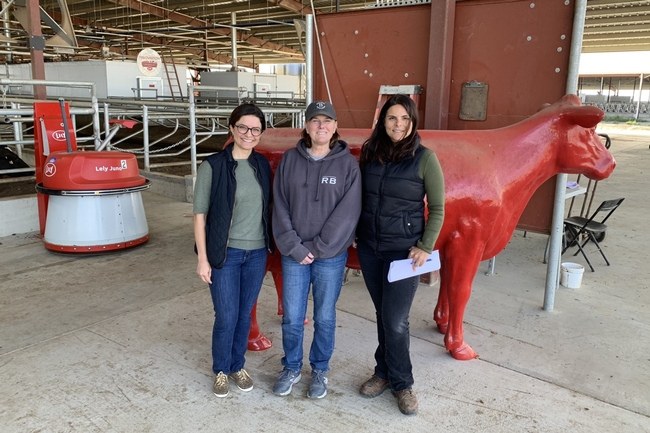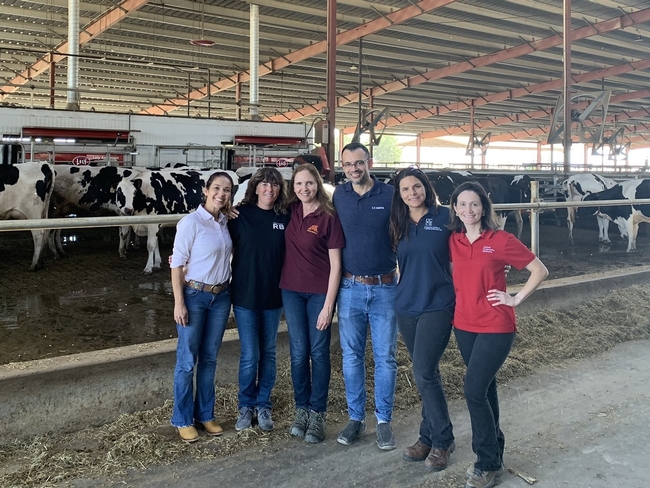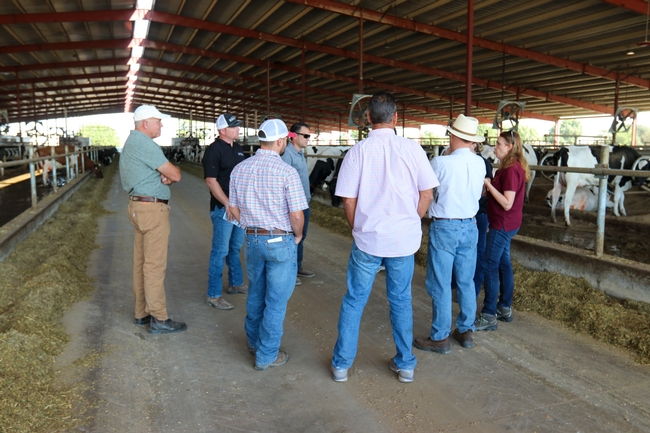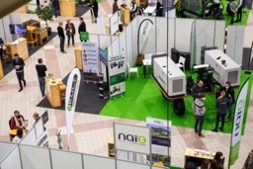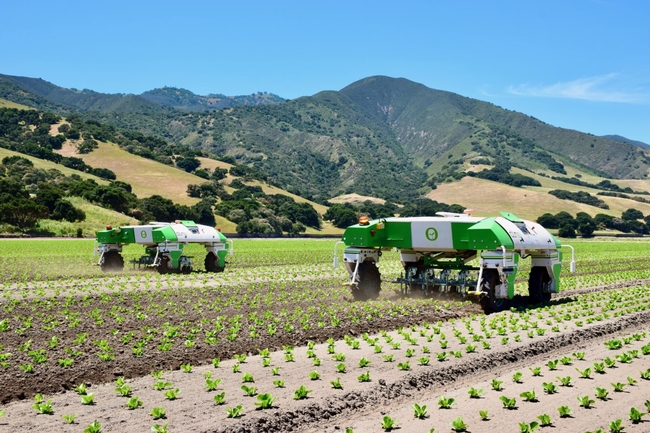Posts Tagged: robotics
Partners unveil first on-farm robotics incubators
Opening in Salinas and Merced in 2025, Reservoir Farms will drive ag innovations in automation robotics
The Reservoir, a nonprofit building tech incubators across California, and partners Western Growers Association, University of California Agriculture and Natural Resources, Merced College, Hartnell College and venture capital firm HawkTower have announced the creation of the first-ever on-farm robotics incubators, Reservoir Farms.
Unveiled during a press conference at the FIRA USA 2024 robotics conference in Woodland, Reservoir Farms are set to open in the Central and Salinas Valleys in early 2025. This pioneering initiative significantly shifts how agricultural technology innovates through real-world testing environments, world-class resources and critical industry partnerships.
California agriculture faces critical challenges, including labor availability and cost, import competition, increased regulation, water scarcity, and climate-related challenges, including extreme weather. These challenges have spurred significant advancements in agricultural precision, automation, mechanization, and robotics in recent years.
Despite advancements, early-stage agtech projects lack critical ecosystem support, like connecting directly with growers, testing and validating their solutions, and accessing dedicated shop space and farmland. These gaps hinder capital efficiency and the development of critical solutions that meet the agricultural sector's needs.
Initial projects at the incubators will focus on early-stage agricultural innovations in automation and robotics, including rovers and drones, that accelerate the development of breakthrough solutions to the opportunities and imperatives faced by California farms producing high-value specialty crops, such as labor shortages, profitability, and adopting climate-smart technologies.
Western Growers Association, a key advocate for advancing agricultural innovation, will provide financial and operational support as an anchor partner.
Anchor educational partners like UC ANR, Hartnell College, and Merced College will play a crucial role in innovation and workforce development, preparing the next generation of agricultural researchers, professionals, and innovators to drive the future of farming in California.
HawkTower, a venture capital firm investing in early-stage startups developing breakthrough innovations for California's environmental and industrial imperatives, is also an anchor partner.
“The launch of Reservoir Farms is a critical step forward in ensuring the future resilience of California's agriculture and across the Central Coast and Central Valley,” said Danny Bernstein, CEO of the Reservoir and managing partner of HawkTower. “By placing incubators directly on the farm, we enable innovators to test, iterate, and scale solutions in real-world conditions as a more immediate path to advance farming communities.”
A new model to incubate agtech innovation
The idea for Reservoir Farms emerged from extensive industry research and consultations with over 50 organizations in the specialty crop sector. Key insights uncovered critical gaps in startups' access to real-world testing environments, shop space, and direct relationships with growers – factors severely hindered capital efficiency and posed a formidable barrier to innovation.
“Our goal is to eliminate the friction points that have historically slowed down the development of new agtech solutions,” said Walt Duflock, senior vice president of innovation at Western Growers Association. “Reservoir Farms offers a new model, where startups can work side-by-side with growers to test their technologies, iterate in a low-stakes environment, and build scalable solutions to improve agriculture's operations.”
Initiative to support thriving agtech ecosystem and job creation
The Reservoir Farms initiative also reflects a broad-based collaboration between key educational institutions, industry players, and local communities to ensure the next generation of agricultural professionals is equipped with the skills needed to support the region's growing agtech sector.
Supporting partners include Central Coast Small Business Development Center (SBDC), Communities Organized for Relational Power in Action (COPA), Digital NEST, Farmhand Ventures, Merced County Farm Bureau, Milano Technical Group, Monterey Bay DART (Drone Automation & Robotics Technology), Monterey Bay Economic Partnership, Monterey County Farm Bureau, Tesserakt Ventures, and The VINE.
“As robotics and automation become more integral to California agriculture, it's essential to have facilities like Reservoir Farms embedded within the farming community,” said Gabriel Youtsey, chief innovation officer at UC ANR. “By bridging the gap between lab-based research and real-world application and accelerating tech transfer, Reservoir Farms can help build the workforce and technology needed to address the critical challenges on the farm, from labor shortages to climate change.”
Focus on specialized services and real-world testing in California's agricultural heartland
Reservoir Farms will open its first two locations in Salinas Valley and Merced in the first quarter of 2025. Participants can lease testing fields and shop space without the burden of multi-year leases, giving them the flexibility needed to scale. The incubators will offer fully equipped R&D workshops, secure storage for expensive equipment, and customized, pre-planted specialty crop fields for testing.
These facilities will be complemented by Reservoir Farms' co-working spaces, meeting rooms, and a robust demo day schedule designed to connect startups with growers, investors, and other key stakeholders.
In addition, the Western Growers Association's validation process will provide startups with a quantitative “scorecard” that offers crucial metrics on scalability, efficacy, and financial viability. This validation, combined with UC ANR's field testing, will help startups refine their products and receive a critical stamp of approval that builds trust with growers and ensures a smoother path to commercialization.
Media Contact:
Jennifer Goldston
AgTech PR for the Reservoir
816-260-0040
jennifer@agtechpr.com
UCCE advisor Bruno guides, learns from dairies switching to milking robots
Automatic milking systems increasingly used in California amid labor challenges
When third-generation dairy farmer Shonda Reid first saw a milking robot at a farm show 13 years ago, she immediately recognized that the technology represented the future. Her father, however, took a bit more convincing.
“I came home and showed him and said, ‘This is what we need to do.' And he thought I was kidding!” said Reid, dairy and farm manager for Fred Rau Dairy, which has a herd of 1,400 milk cows in Fresno County.
Years later, after the family had visited several dairies using automatic milking systems (AMS) across the U.S., they installed their first six robots in November 2021. By fall 2022, they had 24 robots, evenly split between two newly built “free stall” barns where the cows can freely go to the milking machines.
As Fred Rau Dairy was one of the first in California to implement AMS at such a scale, Reid and her team have been instrumental in growing practical knowledge on these systems. She also has been a valued partner to Daniela Bruno, University of California Cooperative Extension dairy advisor for Fresno, Madera and Kings counties.
“Automatic milking robots are not a new technology, but it's new to California,” said Bruno, noting that the milking robots were first used on small, family-run farms in Europe, where the technology granted family members more time for rest and other pursuits.
To better understand the feasibility of milking robots for large dairies in California, Bruno – alongside former UC Davis School of Veterinary Medicine professor Fernanda Ferreira, University of Minnesota researcher Marcia Endres and other collaborators – began a project in 2020 to study the risks and opportunities of automated systems.
“The information is extremely useful for California producers to make informed decisions about implementing AMS on their facilities,” said Denise Mullinax, executive director of the California Dairy Research Foundation, which supported the effort through a competitive grant. “Cow care, labor requirements and profitability are key issues for producers, and CDRF was pleased to support this project which assists producers in understanding how AMS may impact those areas on their facility.”
Dairy farmer: ‘We needed to make some changes'
The project produced a paper analyzing existing research on automatic systems, which have been more widely used in the Midwest, where there are more small-scale, family-run dairies. In 2020, there were only 14 “box robots” in California, according to Bruno. Now there are about 200 across California – and both Bruno and Reid cited labor challenges as the primary reason for the increased use of automated systems.
“California suffers from labor quality and quantity issues,” Bruno said. “By bringing robots to California, you can minimize those problems.”
Higher costs of hiring and retaining employees, driven in part by new labor laws, are one factor. And then there's the reliability and availability of labor, as fewer people are willing to do the physically demanding work of conventional milking.
“People just don't want to milk in a flat barn [a conventional setup where the employee works at the same level as the cow] – there's a lot of kneeling, squatting, that type of thing – it's pretty tough on the body,” Reid explained.
Faced with labor shortages and mounting regulatory burdens, Reid said Fred Rau Dairy had to make the leap to automated systems to keep the 80-year-old dairy operation running.
“We needed to make some changes, or we're going out of the dairy business,” she said.
In a survey conducted by Bruno and her colleagues of large dairies using AMS across the U.S., a majority of the 29 respondents reported reductions in labor costs – but survey results did not offer a definitive picture on whether AMS improved bottom-line profitability.
Calmer, healthier cows
Nevertheless, most of the survey respondents said they were generally happy with their transition to automatic systems.
“It's totally met our expectations, and cow health has gotten much better, too,” Reid said.
In a typical conventional system where cows are outside in “open corral” pens, dairy employees must cajole the cows into the milking parlor. But within a “free stall” barn where the cows can voluntarily go to the milking robots when they want, as often as they want, the animals are much less stressed.
“When you think about cow handling, if you have robots, you don't have anybody pushing and screaming at them to walk to the parlor,” Bruno explained. “You have less cow-people interaction so they are more calm; there is less stress.”
In the survey of large dairies using milking robots, more than 90% of the respondents said their cows were calmer. Reid also noted that many people have noticed how calm their cows are in the free stall barns.
“They're not skittish, you can walk in and they don't run,” Reid said. “They'll just watch you or they'll even come up and start licking on your jacket or shirt.”
Bruno also said that many of the large dairies reported fewer cases of mastitis and other diseases, less lameness, and greater milk production. But she added it's hard to know whether the benefits can be attributed to the robots and their real-time monitoring technology – or to changes in the physical environment (cows save energy in the free stall barn setup, versus the open-corral system that requires walking to the milking parlor).
Dairy producers seek counsel on potential transition
Less bovine travel from outside to inside was a boon for Fred Rau Dairy during last year's unusually wet winter.
“Even if it's just a couple of weeks of rain, that mud and manure and everything – you do what you can, but oh my gosh – it's a mess,” said Reid, noting that easier facility maintenance during extreme weather was another benefit of switching to automatic systems within free stall barns.
Reid shared many of her experiences with attendees of an AMS Field Day in October 2022, arranged by Bruno, Ferreira and their collaborators. About 60 farmers, researchers, industry representatives and consultants visited Fred Rau Dairy and Jones Dairy in Merced County.
If a dairy producer is considering implementing automatic systems, Reid recommends that they research all their options, visit dairies that use the systems, and check who in their area would be providing service and technical support.
And there are crucial workforce considerations, as dairy workers must learn an entirely new set of skills and processes. Instead of spending their time fetching the cows, prepping them and milking them in the parlor, workers might need to gather and interpret data from the robots. “Cow people,” as Reid puts it, must become computer people.
“You have a group of people who have been with you for a while, and you hope that they can transition to the new technology of what you're doing,” Reid said.
During this technological transition, and on the myriad other challenges that dairy operators face, Reid said she is grateful for Bruno's expertise and responsiveness.
“If there's something that I need, she's been really good about trying to help – or putting me in contact with the right people,” she explained. “I've enjoyed working with her.”
The AMS project team also includes UC Davis School of Veterinary Medicine professor Fabio Lima, postdoctoral researcher Thaisa Marques and former postdoctoral researcher Camila Lage.
Robotics are solving water, fertilizer, labor challenges for California agriculture
Global event in Fresno aims to drive ag robotics forward Oct. 18-20, 2022
California agriculture is under tremendous threat from drought, climate impacts and labor scarcity. New robotics and automation solutions are addressing these challenges. To accelerate this innovation to market, a team of partners in California and the International Forum of Agricultural Robotics (FIRA), the leading event in agricultural robotics, will launch FIRA USA in Fresno, California, Oct. 18-20 to provide autonomous systems and robots to California and North America growers.
Jointly organized between the French association GOFAR, the University of California Agriculture and Natural Resources, Western Growers Association and the Fresno-Merced Future of Food (F3) Initiative, FIRA USA 2022 will bring together specialty crop growers, robot manufacturers, industry members, academics, technologists, startups and investors for three days of problem-solving, decision making and planning.
Since 2016, FIRA has primarily hosted its flagship event in Toulouse, France. According to FIRA co-directors Maialen Cazenave and Gwendoline Legrand, “The expert event decided to join forces with local players to launch the first edition abroad: FIRA USA was born.”
An event focused on autonomous solutions for specialty crops
Specialty crops have much to gain from ag robotics and automation. Specialty crops, which the U.S. Department of Agriculture defines as “fruits and vegetables, tree nuts, dried fruits and horticulture and nursery crops, including floriculture,” tend to be more labor intensive to produce and pick, and require more sophisticated technological solutions.
Walt Duflock, Western Growers vice president of innovation, is working to advance the pace of innovation in this sector through the Global Harvest Automation Initiative, which will be presented atFIRAUSA 2022. One of the initiative's goals is to automate 50% of specialty crop harvest in the next 10 years.
FIRA USA to debut in Fresno
“We really wanted to bring a FIRA event to the U.S. because the U.S. market for specialty crops is a key agriculture industry entry point for ag tech startups, so it makes perfect sense to have this event right in the heart of the San Joaquin Valley,” says Duflock. “FIRA USA organizes the entire specialty crop community – educators, commercialization folks, startup companies, and large and small growers—and puts the entire event focus on specialty crop automation for three days.”
From research to robots in fields: A rich three-day agenda
To help ensure the success of this first-time event, FIRA partnered with Gabriel Youtsey, chief innovation officer at University of California Agriculture and Natural Resources.
“FIRA USA is designed for developing practical, real-world solutions, which is the mission of UC ANR,” Youtsey said. “I'm thrilled to advance the ag robotics and automation ecosystem in the Central Valley through this event. Our overall goal is to accelerate the pace of innovation and industry adoption of new technologies that create sustainable growth and profitability of our agriculture industry.”
To keep the event focused on actionable outcomes, FIRA USA is structured to maximize opportunities for networking, learning and collaboration. Each of the three days has a theme: research and development, technology and business day and demonstration.
Oct. 18: The Research & Development Day
The R&D day will bring hundreds of scientists and students together.
This academic day will provide the opportunity for new agricultural technologists in universities around the country that are winning some of the new artificial intelligence grants for agricultural automation to present their projects.
By bringing this academic community together face-to-face in Fresno, FIRA USA aims to set priorities and focus on solving some pain points.
Oct. 19: The Technology & Business Day
With a full exposition zone, panel discussions, breakout sessions and networking times, the second day will bring together the autonomous solutions and end-users.
FIRA USA will engage growers in the conversation to make it real and make presentations more relevant for grower audiences.
In the panel discussions, breakout sessions and roundtables, the participants will build on several big-picture themes: understanding specific specialty crops, introducing different levels of automation and smart technologies, optimizing mechanization, prioritizing value for growers of all sizes, tackling labor shortage, addressing climate-smart objectives, determining appropriate ownership and maintenance models, and more.
Oct. 20: The Demo Day
On the third day, FIRA USA will host in-field robot demos at the California State University, Fresno campus farm.
o Harvesting, weeding, seeding, thinning and planting robots;
o Irrigation automation and data analytics solutions;
o Focus on field crops, fruits & vegetables and vineyards
FIRA USA will run from October 18 -20, 2022, at the Fresno Convention & Entertainment Center in California. The event is organized by FIRA; GOFAR; Western Growers; University of California, Agriculture and Natural Resources; Fresno State, Jordan College of Agriculture Sciences and Technology; and Fresno-Merced Future of Food Innovation.
To learn more about this upcoming event, visit www.fira-agtech.com/event/fira-usa.
ABOUT:
GOFAR
The GOFAR non-profit organization undertakes to promote and develop the agricultural robotics sector at international level. GOFAR meets the increasing need for visibility and networking of the agricultural robotics sector.
GOFAR, therefore, aims to organize the meeting between the relevant stakeholders, and to support them by taking an active part in the development of the agricultural robotics market hence implementing a promotional campaign of international scale (organization of events, production of actions of communication and participation of trade fairs in France and abroad).
The GOFAR association focuses its activity on four main work streams:
- Organizing annually the International Forum of Agricultural Robotics (FIRA), both Online and in-person in Toulouse (France);
- Setting up international collaborations;
- Development of an information platform around the Agricultural Robotics sector – www.agricultural-robotics.com;
- Creation and animation of a network of leading international experts in agricultural robotics.
Websites: www.fira-agtech.comandwww.agricultural-robotics.com
University of California Agriculture and Natural Resources
UC Agriculture and Natural Resources connects the power of UC science and technology in agriculture and natural resources with industry and communities to improve the lives of all Californians.
Our programs focus on solving priority problems that engage scientists, students and industry in integrated teams to work on complex issues.
ANR's field innovation centers located in important California agriculture regions, support research and education. Research projects deliver the highest-quality science to growers, industry and land managers.
Website: https://ucanr.edu
Western Growers Association
Founded in 1926, Western Growers represents local and regional family farmers growing fresh produce in Arizona, California, Colorado and New Mexico. Our members and their workers provide over half the nation's fresh fruits, vegetables and tree nuts, including nearly half of America's fresh organic produce. Some members also farm throughout the U.S. and in other countries, so people have year-round access to nutritious food. For generations, we have provided variety and healthy choices to consumers.
Websites: https://www.wga.com and http://www.wginnovation.com
Fresno-Merced Future of Food (F3) Innovation Initiative
The Fresno-Merced Future of Food (F3) Innovation Initiative seeks to develop world-recognized, “ClimateSmart Food and Agriculture Systems” that provide solutions to economic and environmental challenges within the Central Valley. These solutions will result in both technology that can be exported to solve global food production challenges and increased support for local and regional food systems, including organic production practices and small-scale and socially disadvantaged farmers. F3 champions sustainable food systems that meet human, and ecosystem needs, facilitated by innovation in technologies that are affordable, appropriately scaled and accessible to local farmers and food businesses, with applications for the global farming community.
F3 simultaneously advances workforce training and educational opportunities for local farm and food system workers to ensure just and equitable innovation processes and technology adoption. F3 is one element of the comprehensive Fresno DRIVE investment plan, a ten-year, community-led vitality strategy for inclusive and sustainable economic development in the Greater Fresno Region.
Media Contacts
GOFAR: Gwendoline Legrand – gwendoline@fira-agtech.com
Western Growers: Ann Donahue - adonahue@wga.com
Special thanks to our premium partners: VARTA, Blue White Robotics and Farwest Equipment Dealers Association




